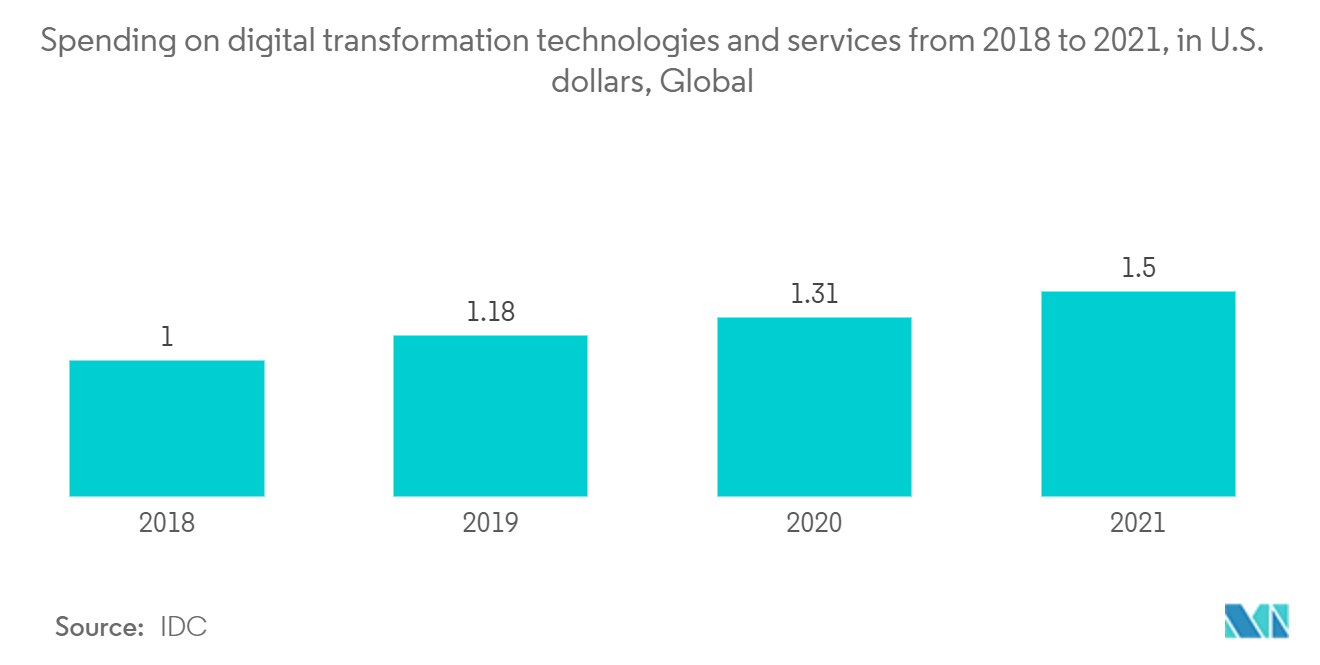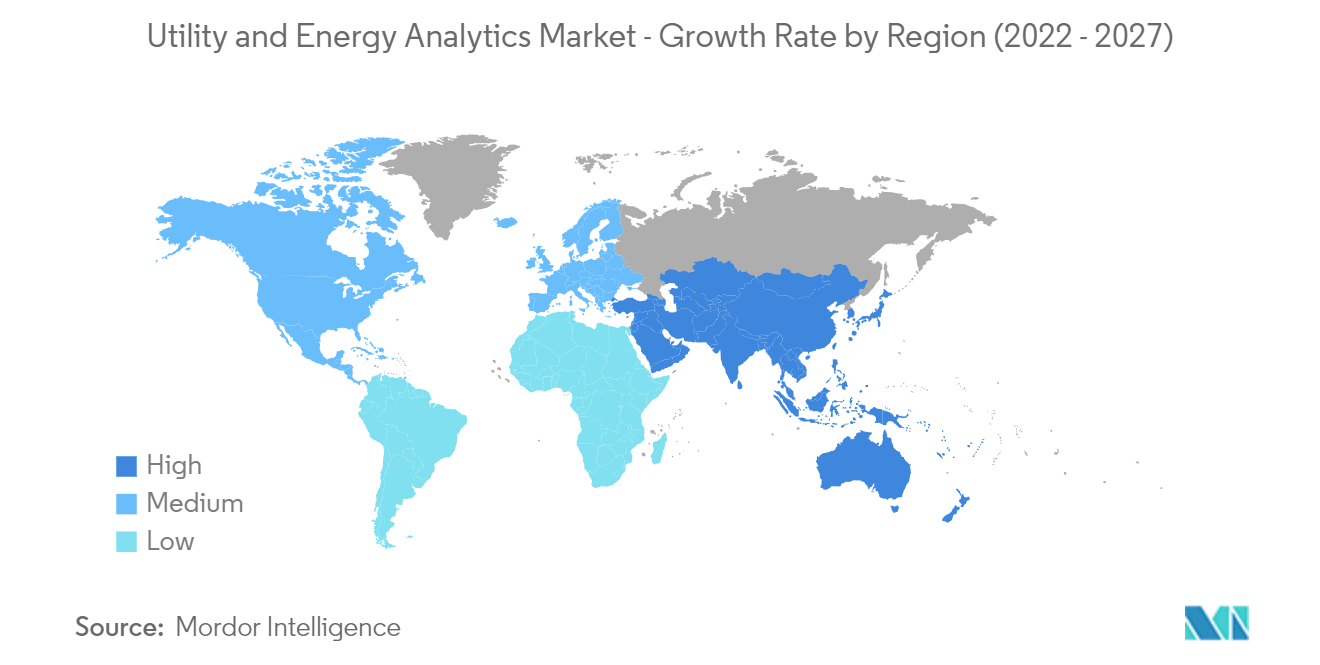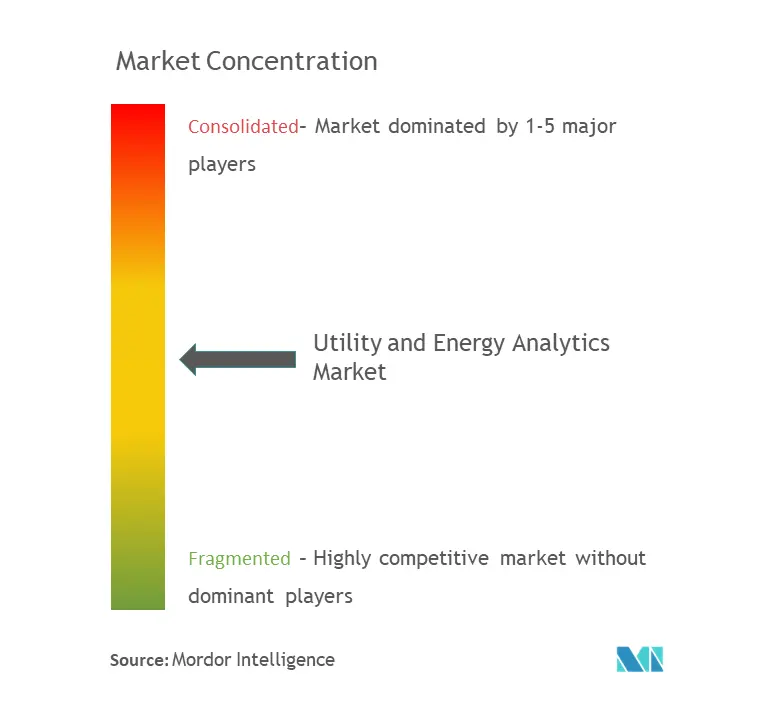Utility and Energy Analytics Market Size

| Study Period | 2019 - 2029 |
| Base Year For Estimation | 2023 |
| CAGR | 24.90 % |
| Fastest Growing Market | Asia Pacific |
| Largest Market | North America |
| Market Concentration | Medium |
Major Players
*Disclaimer: Major Players sorted in no particular order |
Utility and Energy Analytics Market Analysis
The utility and energy analytics market is poised to expand at a CAGR of 24.9% over the forecast period 2022 - 2027. Energy data analytics uses statistics, artificial intelligence, and machine learning. It enables facilities to examine all energy usage across all facilities and equipment. The demand for such advanced technologies is consistently expanding. They can forecast future consumption patterns, compare consumption across facilities, and gain insight into electrical factors such as power, current, and voltage unbalance. The facilities could manage energy use efficiently and responsibly using IoT sensors and other intelligent analytics systems.
- There lies a huge untapped potential for advanced analytics tools and techniques, such as the big data platform and cloud computing. With the rise in the use of the microgrids control system and other smart grid systems, which enable businesses to monitor, control, and analyze grid functioning from a central control center, the market for utility and energy analytics will grow significantly. The need for big data analytics among utility providers is also anticipated to increase as a result of the favorable government legislation supporting smart grid solutions and the exponentially rising usage of smart meters.
- Another significant element that can profit from big data analytics is renewable energy. Technologies utilizing renewable energy are becoming more popular on a global scale, particularly as a dependable source of electricity. According to the IEA, renewable energy capacity is anticipated to grow at a rapid pace in the following five years, accounting for about 95% of the increase in global power capacity by 2026. The global renewable electricity capacity is anticipated to increase by more than 60% between 2020 and 2026, reaching more than 4 800 GW. Solar energy is expected to dominate the renewables market, generating far more electricity in the next four years than hydropower and wind.
- Energy utilities can optimize power generation and planning with analytics solutions. Analytics adoption is well encouraged by the renewable energy industry. When used in renewable energy power plants, predictive analytics can provide precise energy production forecasts. It anticipates mechanical glitches, thereby enhancing operational effectiveness. For instance, to estimate the variable resources for solar and wind power generation, IBM's hybrid renewable energy forecast technique makes use of big data, predictive analysis, and weather modeling technologies. This can provide 10% more renewable energy generation to the system, which is enough to power an additional 14,000 houses.
- Furthermore, there is a vast untapped potential for cutting-edge analytics tools and methods, like the huge information stage and distributed computing, as a result of the expansion in the use of the microgrids control network and other brilliant lattice frameworks, which enable organizations to screen, control, and examine network working from a focal control focus. The demand for extensive information analytics among utility merchants is anticipated to be driven by great government guidelines pushing savvy network arrangements and exponentially expanding reception of shrewd meters.
- Multiple governments across the world are increasingly limiting the movement of people primarily to slow down the spread of COVID-19. Due to this, the utilities and the energy sector may expect a shift in the demand for electricity. The residential consumption and demands on water infrastructure are also expected to witness an increase as people are at home for longer periods of time. The usage of analytics solutions will primarily help these companies better forecast the demand response and make accurate distribution planning.
Utility and Energy Analytics Market Trends
This section covers the major market trends shaping the Utility & Energy Analytics Market according to our research experts:
The cloud-based deployment model is expected to grow at a rapid pace.
- The cloud-based deployment model is anticipated to grow at a rapid rate, aided by technological advancements, leading to high levels of scalability and cost-effectiveness. The markets for load forecasting and demand response are expected to have significant shares of the market over the next five years.
- Predictive analytics plays a crucial role in the utility sector, mainly analyzing the growing data volumes, identifying failing physical assets, and improving customer behavior understanding. Utility companies rely on continuous operation, which includes pleasant functionality at every level. Hence, to avoid massive repercussions, predictive analytics is being widely adopted.
- Moreover, in January 2022, Uptake, a prominent provider of industrial intelligence software-as-a-service, announced a partnership with Cognizant, a significant player in professional services, to allow unified data management for the energy and utility industries. Uptake Fusion, which collects, transfers, organizes, and curates data in Microsoft Azure to provide advanced industrial analytics and asset performance management, has collaborated with Cognizant to provide industry consulting, systems integration, and application services. Industrial organizations can utilize Uptake Fusion in their enterprise cloud environment to supply data for industrial intelligence to internal and third-party data consumers. Users can also use its open APIs as plug-ins with current non-proprietary tools for dashboards, reporting, and monitoring, such as Microsoft Power BI, PowerApps, and Azure Time Series Insights.
- Oracle surpassed its 2020 objective of 33% renewable energy use in Real Estate and Facilities and established a new goal of 100% by 2025. Oracle Cloud also established a new aim of using 100% sustainable energy by 2025. These factors are thus expected to bolster the demand for the market during the forecast period.
- As per IDC, In 2022, the total spending on digital transformation (DX) is projected to reach 1.8 trillion U.S. dollars. By 2025, global digital transformation spending is forecasted to reach 2.8 trillion U.S. dollars. Hence with the rise in digital transformation spending, the market is expected to face various lucrative growth opportunities in the upcoming days.

North America to Lead and Pioneer Market for Utility and Energy Analytics Solutions
- North America is regarded as one of the greatest markets for utilities and energy analytics and is one of the top adopters of analytics solutions. The region's demand is mostly driven by developed economies' increased emphasis on innovations through R&D and technological improvement. When compared to Canada, the United States is a major factor in increasing the demand from the region. Demand in the nation has increased, particularly from the oil and gas, refining, and power generation sectors.
- The region has a strong foothold of manufacturers in the market. Some of them include SAS Institute Inc, Oracle Corporation, BuildingIQ, and IBM Corporation, among others. Also, the region has been at the forefront of adopting smart grid technology. A vast number of companies operating in the energy utility sector in the region have either fully deployed big data analytics or are in the process of implementation. Many large investor-owned utilities in the US market are still in the process of rolling out smart meters for their customers.
- The US Energy Information Administration predicts that between 2016 and 2040, global energy consumption will rise by 5%. Companies must cut downtime to sustain profitability effectively in light of the low growth rate. The market for data analytics in utilities and energy is fueled by this. In order to decrease energy use, the US government is also modernizing its energy systems and switching to Advanced Metering Infrastructure (AMI). For instance, the residential sector saw the highest rate of AMI adoption in the nation, according to the US Energy Information Administration (EIA). Canada has a high smart meter penetration rate as a result of the country's ambitious endeavors in its most populous regions. It is also expected that a large number of smaller municipal and cooperative utilities will be crucial to market penetration.
- The Institute for Electric Efficiency predicts that by 2024, there will be 90 million smart electricity meters shipped annually in the US, up from 61 million in 2015. The deployment of smart meters by several businesses, including Consolidated Edison, Duke Energy, Ameren, Entergy, PSEG, National Grid, and Xcel Energy, is anticipated to increase the number of smart meter shipments over the next years.
- Furthermore, the electric power companies in the region are exploring new technologies to serve increasingly sophisticated customers to expect a high-tech digital experience. Utilities in the country are highly using big data for better decision-making. Baltimore Gas & Electric, a gas and electric utility, makes numerous process and organizational changes to support and drive value from a centralized data analytics solution.

Utility and Energy Analytics Industry Overview
The utility and energy analytics market is extremely competitive and consists of several major players. These major players, with a prominent presence in the market, are focusing on expanding their customer base across the market segments. The companies are leveraging strategic collaborative initiatives to increase their market share and improve profitability. The companies functioning in the market are also acquiring or partnering with start-ups working on utility and energy analytics technologies to strengthen their product capabilities and introduce new features.
- July 2022 - Matterport, Inc., the leading spatial data company driving the digital transformation of the world, announced a partnership with Burns & McDonnell, an engineering, construction, and architecture firm providing services for critical infrastructure companies. Through the partnership, Burns & McDonnell customers can use the Matterport Digital Twin Platform, including software services and hardware, to optimize construction expansion and maintenance projects. The collaboration equips businesses in the energy, utilities, and manufacturing industries with a continuous digital, visual documentation solution that improves operations, enhances collaboration and increases safety in each project stage.
- December 2021 - The provider of digital information systems for hospitals and healthcare institutions, Cerner, was purchased by Oracle Corporation. Cerner utilizes big data analytics to store and process the patient's data. Additionally, this acquisition will make it possible for medical experts to provide both communities and specific individuals with improved healthcare.
- September 2021 - Snohomish County Public Utility District (Snohomish PUD), which is the second-largest publicly owned utility in Washington state, selected TRC Companies to implement, integrate and deliver its meter data management on the Siemens EnergyIP solution as a part of the utility's Connect Up program.
Utility and Energy Analytics Market Leaders
-
Oracle Corporation
-
Capgemini SE
-
ABB Limited
-
IBM Corporation
-
General Electric Company
*Disclaimer: Major Players sorted in no particular order

Utility and Energy Analytics Market News
- August 2022 - mCloud Technologies Corp., a leading provider of AI-powered asset management and Environmental, Social, and Governance ("ESG") solutions, announced that it has entered into a technology continuation agreement with Agnity Global Inc., enabling mCloud to build on the success of its existing relationship with Agnity.
- May 2022 - Siemens introduced its time-tested transmission grid simulation software, PSS-E, to the cloud. It leverages the same software and user interface, with over 2,000 APIs and the use of existing scripts. It provides scalable computation power, flexible remote working, a secure collaboration environment, etc. This is currently available in the United States and Canada, with a future global rollout planned.
Utility and Energy Analytics Market Report - Table of Contents
1. INTRODUCTION
- 1.1 Study Assumptions and Market Definition
- 1.2 Scope of the Study
2. RESEARCH METHODOLOGY
3. EXECUTIVE SUMMARY
4. MARKET INSIGHT
- 4.1 Market Overview
-
4.2 Industry Attractiveness - Porter's Five Force Analysis
- 4.2.1 Bargaining Power of Suppliers
- 4.2.2 Bargaining Power of Buyers
- 4.2.3 Threat of New Entrants
- 4.2.4 Threat of Substitute Products
- 4.2.5 Intensity of Competitive Rivalry
- 4.3 Impact of COVID-19 on the Market
5. MARKET DYNAMICS
-
5.1 Market Drivers
- 5.1.1 Rising Demand for Energy and Increasing Emphasis on a Greener Environment
- 5.1.2 Growing Consumer Focus on Energy Consumption Pattern Analysis
-
5.2 Market Challenges
- 5.2.1 Compatibility Issues and Skill Gap
- 5.2.2 Security Concerns
6. MARKET SEGMENTATION
-
6.1 By Deployment
- 6.1.1 Cloud
- 6.1.2 On-premise
-
6.2 By Type
- 6.2.1 Software
- 6.2.2 Services
-
6.3 By Application
- 6.3.1 Meter Operation
- 6.3.2 Load Forecasting
- 6.3.3 Demand Response
- 6.3.4 Distribution Planning
- 6.3.5 Other Applications
-
6.4 Geography
- 6.4.1 North America
- 6.4.2 Europe
- 6.4.3 Asia-Pacific
- 6.4.4 Latin America
- 6.4.5 Middle East & Africa
7. COMPETITIVE LANDSCAPE
-
7.1 Company Profiles
- 7.1.1 Oracle Corporation
- 7.1.2 Capgemini SE
- 7.1.3 ABB Corporation
- 7.1.4 IBM Corporation
- 7.1.5 General Electric Company
- 7.1.6 SAS Institute Inc.
- 7.1.7 Siemens AG
- 7.1.8 Schneider Electric SE
- 7.1.9 SAP SE
- 7.1.10 Teradata Corporation
- *List Not Exhaustive
8. INVESTMENT ANALYSIS
9. FUTURE OF THE MARKET
** Subject To AvailablityUtility and Energy Analytics Industry Segmentation
With new structured and unstructured data sources, including IoT data, and increasing competition from suppliers of alternative energy, the analytics landscape for energy and utility firms are rapidly evolving. Utility organizations require data solutions that directly impact company performance by reducing costs, improving services, identifying hazards, and effectively supporting customer engagement in order to accurately estimate demand, reduce expenses, and expand business decisions. The scope of the study involves various deployment methods across different types in multiple geographies.
The Utility and Energy Analytics Market is segregated by Deployment (Cloud, On-premise), Type (Software, Services), Application (Meter Operation, Load Forecasting, Demand Response, Distribution Planning), and Geography.
| By Deployment | Cloud |
| On-premise | |
| By Type | Software |
| Services | |
| By Application | Meter Operation |
| Load Forecasting | |
| Demand Response | |
| Distribution Planning | |
| Other Applications | |
| Geography | North America |
| Europe | |
| Asia-Pacific | |
| Latin America | |
| Middle East & Africa |
Utility and Energy Analytics Market Research FAQs
What is the current Utility and Energy Analytics Market size?
The Utility and Energy Analytics Market is projected to register a CAGR of 24.90% during the forecast period (2024-2029)
Who are the key players in Utility and Energy Analytics Market?
Oracle Corporation, Capgemini SE, ABB Limited, IBM Corporation and General Electric Company are the major companies operating in the Utility and Energy Analytics Market.
Which is the fastest growing region in Utility and Energy Analytics Market?
Asia Pacific is estimated to grow at the highest CAGR over the forecast period (2024-2029).
Which region has the biggest share in Utility and Energy Analytics Market?
In 2024, the North America accounts for the largest market share in Utility and Energy Analytics Market.
What years does this Utility and Energy Analytics Market cover?
The report covers the Utility and Energy Analytics Market historical market size for years: 2019, 2020, 2021, 2022 and 2023. The report also forecasts the Utility and Energy Analytics Market size for years: 2024, 2025, 2026, 2027, 2028 and 2029.
Utility and Energy Analytics Industry Report
Statistics for the 2023 Utility and Energy Analytics market share, size and revenue growth rate, created by Mordor Intelligence™ Industry Reports. Utility and Energy Analytics analysis includes a market forecast outlook to 2029 and historical overview. Get a sample of this industry analysis as a free report PDF download.



